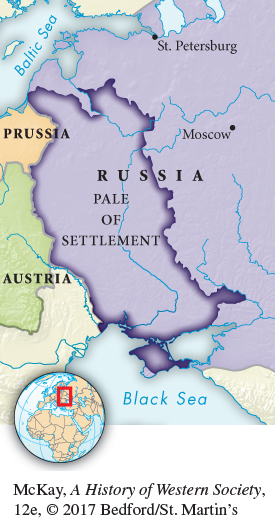A History of Western Society: Printed Page 538
A History of Western Society, Value Edition: Printed Page 517
A History of Western Society, Concise Edition: Printed Page 539
Jewish Life and the Limits of Enlightened Absolutism
Perhaps the best example of the limitations of enlightened absolutism are the debates surrounding the emancipation of the Jews. Europe’s small Jewish populations lived under highly discriminatory laws. For the most part, Jews were confined to tiny, overcrowded ghettos, were excluded by law from most professions, and could be ordered out of a kingdom at a moment’s notice. Still, a very few did manage to succeed and to obtain the right of permanent settlement, usually by performing some special service for the state. Many rulers relied on Jewish bankers for loans to raise armies and run their kingdoms. Jewish merchants prospered in international trade because they could rely on contacts with colleagues in Jewish communities scattered across Europe.
In the eighteenth century an Enlightenment movement known as the Haskalah emerged from within the European Jewish community, led by the Prussian philosopher Moses Mendelssohn (1729–1786). (See “Individuals in Society: Moses Mendelssohn and the Jewish Enlightenment.”) Christian and Jewish Enlightenment philosophers, including Mendelssohn, began to advocate for freedom and civil rights for European Jews. In an era of reason and progress, they argued, restrictions on religious grounds could not stand. The Haskalah accompanied a period of controversial social change within Jewish communities, in which rabbinic controls loosened and heightened interaction with Christians took place.

Arguments for tolerance won some ground. The British Parliament passed a law allowing naturalization of Jews in 1753, but later repealed the law due to public outrage. The most progressive reforms took place under Austrian emperor Joseph II. Among his liberal edicts of the 1780s were measures intended to integrate Jews more fully into society, including eligibility for military service, admission to higher education and artisanal trades, and removal of requirements for special clothing or emblems. Welcomed by many Jews, these reforms raised fears among traditionalists of assimilation into the general population.
Many monarchs rejected all ideas of emancipation. Although he permitted freedom of religion to his Christian subjects, Frederick the Great of Prussia firmly opposed any general emancipation for the Jews, as he did for the serfs. Catherine the Great, who acquired most of Poland’s large Jewish population when she annexed part of that country in the late eighteenth century, similarly refused. In 1791 she established the Pale of Settlement, a territory including parts of modern-
The first European state to remove all restrictions on the Jews was France under the French Revolution. Over the next hundred years, Jews gradually won full legal and civil rights throughout the rest of western Europe. Emancipation in eastern Europe took even longer and aroused more conflict and violence.